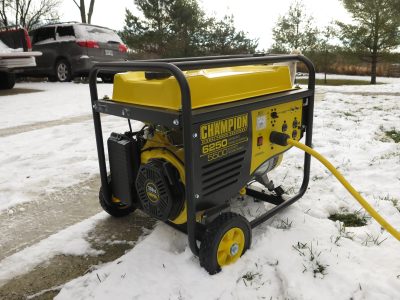UPDATED 24Oct2019: Home generators can make up for a sad reality of life these days. The reliability of our electricity supply isn’t what it used to be. Utility companies have cut back on line maintenance and sometimes electricity demand across North America almost exceeds supply. The continent-wide, interconnected electrical grid means that power failures can ripple outwards like falling dominoes. It’s hard to find anyone who hasn’t experienced a power outage. Home generators offer a safe and convenient way to provide power to a home when an outage occurs. And while none of this is news, what you might not realize is how far small-scale home generator technology has advanced. It’s now more practical than ever for proactive homeowners to meet their own emergency power needs, and to meet it at lower cost than ever. Success begins by understanding your needs and options, and this is what you’ll get in this report.
Exactly What Are Home Generators?
This sounds like a simple question, but it’s worth asking. Home generators convert the energy in gasoline, diesel fuel, propane or natural gas into electrical energy of the kind used by us all in everyday life. Home generators sold in North America put out 120 volts or both 120 and 240 volts, just like the power that comes into your home from the local utility. Generators can be large or small, portable or stationary, but they’re essential energy conversion devices.
Where I live we get at least three or four extended power outages each year. Sometimes more. That’s one reason I invested in my first home generator back in 1988. Building and renovating beyond the grid is another reason why home generators are a part of my life. Considering a portable generator for your own place? This report explains the key issues you need to know about choosing and using your own. In this report you’ll learn how to:
• Choose the Right Size of Home Generator
• Understand Weight, Portability and Voltage Output Issues
• Decide Between a Generator and an Inverter Generator
• Connect Home Generators to Your House
• Maintain Home Generators Properly
Click here for a buyer’s guide on choosing a home generator.
Home Generators Lesson#1: Choosing the Right Size of Generator
Home generators put out different amounts of power, and deciding how much power you want is the first step in the selection process. Watts are the universal method of measuring power consumption in the electrical world, and watts are how generator sizes are rated. Add up the wattage of all the items you plan to use during a power failure, add an allowance for extra capacity, and that’s the size of generator you need. Sounds simple enough, but there are complications.
First of all, not all electrical items have wattage ratings stamped on them. Voltage and amperage numbers, however, must be shown by law on all electrical items, and that’s a good thing. Simply multiply voltage and amperage specs to get a wattage consumption figure. This is a good starting point, but there’s more. You also need to realize that some items draw a lot more power during start up than they do while running. Some, but not all.
Take a look at “Watt’s What” below for a sampling of electrical items and their wattage demands. Those with what’s called an “inductive” load include motors that draw a substantial spike of start-up current over and above what they need while running. Your generator needs to be sized to accommodate this extra current draw for at least some of the inductive items on your list. Not all will be starting up at once, of course, so you’ll need to use some judgement as you tally your figures.
Watt’s What?
Add up the wattages below to determine the size of back-up generator you need. Use peak watt specs for items that draw a surge of start-up current. Also, count on only 80% of a home generator’s rated output being available continuously.
The best online tool I’ve found for determining the size of home generators you need is at this link: www.championpowerequipment.com/generator-selector. Just click the items you want to power, then the tool tells you the size of generator you need. It automatically takes inductive loads into consideration.
While it’s important for you to add up the amount of power you expect to use, then size your home generator accordingly, there are some shortcuts to help you in making a decision. Most people find a 3500 watt home generators sufficient for bare-bones basic household needs. But in this case bare bones really means bare bones. A 3500 watt unit will be able to handle a household water pump, basic lighting, a fridge, a freezer and a small hot plate, though not all at once. I consider a 3500 watt generator the absolute minimum you’d want to connect to your home. A 5500 to 6500 watt model offers more options and less chance of overloading the generator. The real-world difference between a 3500 and 6500 watt model is significant. A 7500 to 9000 watt is even better.
Completely powering a modern home just as normal during an extended outage can easily require 10,000 to 20,000 watts. And while this report is mostly about portable generators, you should know that “standby generators” also exist for larger outputs. These are permanently mounted next to your home, and they switch ON and OFF automatically as needed. A 12,500 watt standby unit, for instance, costs about $3000. These units can’t be moved around, but they do offer the lowest cost-per-watt figures of all generators, along with quiet operation, automatic switching and a quality of power output that’s worth taking a closer look at. More on this later.
Why We Have an Electrical Grid At All?
So if the electrical grid makes us all vulnerable to widespread power failure, why do we have a grid at all? Why don’t we have local generation and distribution? Well, we almost didn’t and the story goes back to the origins of our continent-wide electrical system.
On November 16, 1896, electric lights switched on in Buffalo, New York for the first time. It was one of the first examples of the centralized, grid-based electrical system we have today and it was the outcome of a technological struggle. Beginning in the late 1880s, the two giants of invention, Thomas Edison and Nikola Tesla, battled for two different philosophies for electrifying the world. Edison favoured a system that used direct current supplied over short distances by local generating stations. This was the “non-grid” option. Tesla, on the other hand, was a firm believer in alternating current (AC) delivered by centralized generating stations over much larger distances. This AC system is the forerunner of the electrical grid we have today, and it’s what the authorities in Buffalo decided to implement along with other jurisdictions working hard to electrify their regions. Although Tesla’s centralized AC approach does have significant advantages over a decentralized DC system, one of the drawbacks is the vulnerability of any large electrical grid. An overload, terrorist attack or EMP (electromagnetic pulse) event in one part of the country can cause a ripple effect that shuts down the electrical supply thousands of miles away. Ultimately, the entire electrical system of North America is one big technological organism. Kill one part of it and the rest can die.
Will a widespread grid collapse disaster occur? No one knows for sure, but the situation seems ripe for one. And if you wait for it to happen before preparing, you’ll be too late.
Home Generators Lesson#2: Understanding Generator Weight, Portability and Voltage Output
The bigger the generator, the more it weighs. That’s obvious enough, but this issue matters because portable generators are always on the move. You’ll pull your generator out of the garage when the lights go off, take it to the cottage to work away from the grid, or share your generator with a friend to keep their freezer cold when the power stays off for days. What’s less obvious about generator size is that it doesn’t always affect portability the way you think.
Large home generators, for instance, can sometimes be easier to move than a smaller one if the bigger machine is equipped with wheels and a handle. Wheels make a huge difference. Also, if you only ever need to power small items, then it doesn’t make sense to get a big generator “just in case”. It really is nice to be able to tote around a small generator as easily as a toolbox if all you need is 1000 watts of power.
Generator size also has an influence on voltage output in an indirect way. Voltage (as measured in “volts”) is different than the amount of power a generator puts out as measured in watts, and to understand voltage you need to understand how houses and appliances are designed.
Expensive Versus Economical: What’s Best?
The first thing you’ll notice when shopping for home generators is the widely differing price levels. You can pay $4000 for a top of the line 6500 watt model or $1000 for the same size machine of another brand. Does this price difference matter? Yes and no. It used to be that lower priced generators were little more than loud, inefficient and unreliable, but that’s changed. Competition has driven generator prices down while quality of economy models is on the rise. Buying a less expensive generator from a reputable source with product support makes a lot of sense, especially if you’ll only be using your generator for emergency backup power. The best economy-priced generator line I’ve seen so far is Champion. I’ve personally owned and used Honda, Ridgid, Yamaha and a number of Chinese-made generators. As of May 2016, Champion has the best network of dealers, repair shops and parts in the value generator scene.
Voltage is a measure of electrical pressure. Think of it like water pressure. Low voltage corresponds to water coming out of your garden hose without much force. Higher voltage is like water blasting out of the hose. Every grid-connected home in North America is supplied with electricity of two voltages: 120 volts and 240 volts. The reason for a two-voltage supply is because that’s the way our electrical devices are designed. Most items are made to use 120 volts, but bigger items such as an electric range or clothes dryer requires a 240 volt circuit. What does all this have to do with generator size and weight? Quite a bit.
If you plan to connect your home generator to your house (I’ll explain why and how later), then you need to choose a generator that supplies both 120 volt and 240 volt power at the same time. Not all models do. Connecting a generator to your home is an excellent way to get the most value from your investment, but if you are going to do so you need to choose a generator that offers both 120 volt and 240 volt output.
Generally speaking, generators up to about 3000 watts deliver 120 volt power only, not 240 volts. This is just the way things are, and 120 volts is fine for energizing small items using extension cords. But 120 volt power alone won’t energize your house. Even if you’ll think you’ll only ever need a few thousand watts to power the circuitry in your home (and never plan to power the 240 volt items in your life), you still need to choose a generator that offers both 120 volt and 240 volt output to make that all-important direct connection. It’s all about the design of household electrical systems.
Home Generators Lesson#3: Deciding Between a Generator and an Inverter Generator
As you shop for a generator you’ll notice there are two main types on the market. The vast majority of models are called “generators” and this includes both portable and stationary types. There’s also something called “inverter generators” which are different. To understand this difference you need to start with some history.
Until a decade or so ago, ordinary portable generators produced electricity that was”dirty” enough to sometimes harm sensitive electronics such as computers, TVs and music equipment. The measure of generator power cleanliness is described by something called “total harmonic distortion” (THD). The lower the number the cleaner the power. To overcome the problem of dirty power, inverter generators were invented.
Inverters Versus Inverter Generators
In the world of electricity, inverters are not the same as inverter generators. It’s confusing, I know, but let me explain. An inverter is a device that converts direct current electricity (DC) to alternating current (AC). Inverters don’t produce power, they just convert it. Inverters are typically used in alternative electric systems to convert the electricity from a battery to the kind of AC electricity you can use for plug-in household items. By contrast, an inverter generator has an engine that actually produces electrical power by burning fuel.
Inverter generators get their name from the fact that they initially produce direct current (DC) power internally, then convert this to alternating current (AC) electronically before making it available to your home. This conversion process is where the term “inverter” comes in, and the resulting output is pure sine wave power – at least as good and clean as what comes out of a wall socket.
While inverter generators were being developed to overcome the problem of dirty power, generators were also being developed to produce clean power that could run all household items safely. That’s usually the case with generators today. So why do we still have inverter generators when clean power comes from ordinary generators? A couple of reasons. Inverter generators are quieter and use less fuel than a comparable generator, and this matters in situations like trailer parks, cottages, campgrounds or any place where the less noise the better.
Inverter generators do cost more per watt of output than conventional generators and they’re not available in large sizes. On the plus side, besides offering very clean power, inverter generators are just plain easier to live around. They’re often equipped with a variable load feature that controls motor speed depending on the electrical load demanded. If you’re demanding only 10% of the inverter generator’s capacity, engine speed will run just slightly more than an idle; 50% demanded current draw in the motor will run half speed. Full demand, full engine speed. This variability is the detail that translates into quieter operation and reduced fuel consumption. Inverter generators are also lighter and more compact than their open framed counterparts, so if portability and storage space are important, this may be the better choice.
So how do you know if you need an inverter-generator? Will a conventional generator do the job? Answering these questions comes down to what’s important to you. If you’re willing to pay a premium for much quieter and more economical operation of small items requiring only 120 volts, then an inverter generator is for you. If you need more than about 3000 watts of power or need both 120 volts and 240 volts of output, then a generator is definitely what you want.
Home Generators Lesson#4: Connecting to a Generator
The simplest way to get power from the generator to household appliances is to run extension cords from the generator in your yard into your home through an open window or door to power your fridge, TV or kettle. However, that can be a pain (especially in winter), and besides, the really important items in your home are all hard-wired into the electrical system anyway. Your furnace might run on natural gas, but it still needs electricity to function – electricity that you can’t provide using an extension cord. Same goes if your house is connected to a well. Water won’t flow until you get power to your pump, and most pumps are hardwired to the grid electrical supply. Lights, security systems and wall outlets always depend on a direct connection between a generator and an electrical panel. This job can happen in different ways.
For safety reasons, regulations everywhere require that some kind of switching gear be installed between the electrical panel in your house and whatever home generator you might want to connect to that panel. This switching gear is designed so that either the generator provides power to your house or the electrical grid does, but never both sources to your home at the same time. Also, your generator must never be allowed to feed power directly to the grid since this would endanger line workers. Imagine what it would be like working to repair some flaw in overhead wires, only to have those wires inadvertently energized by the generator of someone living miles away.
For years, safe connection of home generators to electrical panels was done through manual or automatic switches wired into the large cables coming into your home. This is still an option and some people have them installed. The challenge is that it can be difficult and expensive to have this kind of wiring added to an existing household electrical system. One unique alternative is called Generlink. It’s the simplest way I know of to make a safe and legal generator connection to your house because it doesn’t require wiring. The Generlink unit gets installed by a licensed electrician behind your outdoor electrical meter. There’s a port on the bottom of the Generlink to accept a cable that conducts electricity to your house. This cable connects the generator to the Generlink, creating a system that’s more than just safe. It’s also intelligent.
The Generlink delivers generator power to your home while the grid is down and your generator is running, but as soon as grid power comes on again, it switches back to grid power. If your generator is like many these days, with a system that automatically throttles back the engine to an idle when no power is being demanded, your ears will tell you when you can switch the generator OFF until the next power failure. I use a Generlink at my place and it works great.
Generlink is a US product (www.generlink.com; 770-736-8232) and it’s also available in Canada through a company called Jesstec Industries (800-891-9380). I discovered Generlink in 2008 and I’ve been monitoring the performance of this technology since then. A few people have had trouble with the units failing to switch back to grid power when it came back on, but failure rates have been less the 0.02 % of units sold, based on my research. On the plus side, using a Generlink is pretty simple. When a power failure strikes, connect your generator to the Generlink with a cable then fire up the engine, though not before you’ve made some decisions.
Since most portable generators aren’t powerful enough to handle large loads such as a water heater, baseboard heaters or clothes dryer, you need to visit your household electrical panel and switch off circuits you don’t want your generator attempting to supply. If you demand too much power and trip the breaker on the generator, it’s no big deal. Just reset the breaker and use less power. Your electrical panel becomes the place where you can exercise this control by switching OFF circuits so they can’t be used accidentally.
Home Generators Lesson#5: Maintenance
Of all the outdoor power products in the world, home generators probably work the hardest. Does your lawn mower ever run full blast for days on end? Does your rototiller operate constantly in summer and winter? A generator might not operate that often, but when you do fire it up, that generator works really hard. So how does this affect you as a generator owner? A couple of ways.
First and foremost, a working generator needs to be treated to more frequent oil changes that you’re used to with other engine-powered items. Well, it seems like greater frequency, but it’s not really. The rule of thumb for any small gasoline engine is to change the crankcase oil after every 25 hours of operation. And while this applies to all small, air-cooled, 4-stroke engines (generators included), you’ll rack up those hours much more quickly on a generator than you will with, say, a lawn mower. Use a generator for half the time during a power failure and you’ve hit the 25 hour limit in just two days. Leave your generator running all the time and you’ll need to change the oil every day. All this is why you need to keep oil on hand for changing during an extended power failure. The longer the outage extends, the more precious your generator will be. Prepare to treat it right by having fresh crankcase oil on hand. You may not be able to buy any during an extended outage, so stock up.
Another maintenance issue has to do with fuel. Gasoline doesn’t stay fresh forever sitting in the can, and this matters when it comes to keeping your generator running smoothly. There are different strategies you can follow for making this happen. First, you can use and replace stored fuels regularly. Here at my place I keep half a dozen 5-gallon gas cans full at all times, then use them to fill up my vehicles when it’s time to refill the cans with fresh fuel. Gasoline is formulated to be more or less volatile depending on the season. Summer gas won’t burn perfectly in winter, and winter gas doesn’t perform optimally in summer. Stale gas can make your generator run poorly all the time.
Want to reduce the hassle of rotating fuel supplies to keep it fresh? Adding gasoline preservative liquid to your fuel reserves will keep gas fresh and trouble-free for at least six months. I’ve never had any trouble storing and using preserved gas for a year. Using fuel preservative liquid means you need to rotate fuel less often, and it’s also essential for putting in the tank of your generator. Allow this treated gas to run through the carburetor before shutting the generator down, to ensure easy starting later on. Gas preservative makes a big difference and is available wherever automotive and mechanical products are sold. You only need to add 10 or 20 milliliters to each tank of generator fuel. Natural gas or propane fired generators have no fuel storage issues since these fuels don’t deteriorate with time. This is one reason all permanently mounted, standby generators usually operate on propane or natural gas. Some portable generators are made to operate on multiple fuels, too. You’ll find models that can operate on gasoline, propane a natural gas – whatever is available to you.
Home generators are better than ever and cheaper than ever, so it’s easy to like them. Generators are also more important than ever. It’s wise insurance to own and be able to maintain one. Choose well and if you’re like me, you might even find yourself looking forward to the next power failure and the chance to fire up that little bit of electrical independence.
















